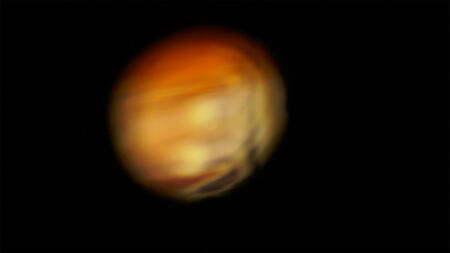"Atlas" by Pablo Vargas Lugo at the Museo Universitario del Chopo (Mexico)
"Atlas" by Pablo Vargas Lugo at the Museo Universitario del Chopo (Mexico)

The plastic artist Pablo Vargas Lugo presents Atlas, a video piece made from the brilliant Star Gate sequence, which constitutes the climax of 2001: Odyssey in Space (1968), by the American filmmaker Stanley Kubrick.
The formal patterns of the wings of 25 different species of butterflies are the central motif of Vargas Lugo's piece. Atlas traces, in broad strokes, the sequence of the Kubrick film in its times and rhythms, reproducing some technical aspects, specifically the slitscan technique, which deforms the image.
In collaboration with the film photographer Rafael Ortega, the artist filmed these patterns in a set designed to perform macro photography, in which it was possible to make precise routes on the wings, whose size does not exceed 10 x 10 cm. Also, the musician Juan Cristóbal Cerrillo created an original composition for this piece.
It is worth remembering what is the sequence known among moviegoers as Star Gate: the astronaut David Bowman enters the mysterious monolith that orbits the planet Jupiter and is dragged by a dizzying path of lights and abstract forms, which seems to witness the birth of the universe and lose all spatial and temporal reference.
In the last third of the sequence landscapes appear whose altered colors are interspersed with shots of the equally altered eye of the astronaut, indicating a significant change in perception and consciousness. This scene, lasting about ten minutes, is the model that the artist takes to structure Atlas.
According to Itzel Vargas Plata, curator of the exhibition, this video piece is part of a project that Vargas Lugo started in 2007, in which he has explored anomalous ways of representing the patterns that identify different species of butterflies. Through this project, the artist has satiated his curiosity about the origin, structure and details of these insects, and has offered a representation of nature that displaces hierarchies of scale, lineage and time. The pieces Hamadryas Guatemalena marmarice Mandala (2007) belong to this project; Lo Res (2010); the New Neotropical vexilology series (2011-2015); Mariposario (2011-2015) and Stone Garden (2014).
About the artist
Pablo Vargas Lugo (Mexico City, 1968). studied Visual Arts at the National Autonomous University of Mexico (UNAM). Since 1991 he has participated in numerous solo and group exhibitions. His work includes space technology, writing, measuring time, as well as the mimetic or dissuasive patterns of some insects that communicate through unusual technical, visual and conceptual alignments. Some of his most outstanding exhibitions are: Micromegas, at the Museo Tamayo Arte Contemporáneo and the Amparo Museum (2014); Outdoor, at the El Eco Experimental Museum (2012); Eclipses for Austin, at the Blanton Museum of Art in Austin, Texas (2009); Contemporary Projects, at the Los Angeles County Museum of Art (2005); Vague Statistique, in the Siqueiros Public Art Room (2003); Congo Bravo, in the Carrillo Gil Museum (1998). He participated in the 26th São Paulo Biennial (2004); Biennial of Cuenca (2004); 5th Mercosur Biennial (2005); as well as in the 3rd Polygraphic Triennial of San Juan (2012). His work has been presented in collective exhibitions in various venues: University Museum Contemporary Art (MUAC) of the UNAM; Centro de las Artes, in Monterrey; Zapopan Art Museum, in Guadalajara; Palais de Tokyo, in Paris; Reina Sofía Art Center, in Madrid; Museum of Latin American Art of Buenos Aires, in Argentina; Hammer Museum of Art, in Los Angeles; PS1, in New York; The Museum of Fine Arts, in Houston; and Museum of Art of Lima, in Peru.
"Atlas" by Pablo Vargas Lugo
Inauguration: February 6, 2018, 6:30 pm, Galería Sur
Free entry
CHOPO UNIVERSITY MUSEUM
Dr. Enrique González Martínez no. 10, Col. Santa María la Ribera
Tel. 5546 8490, 5546 3471, 5535 218
More information: info.chopo@unam.mx




